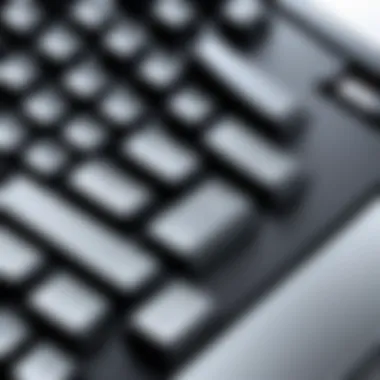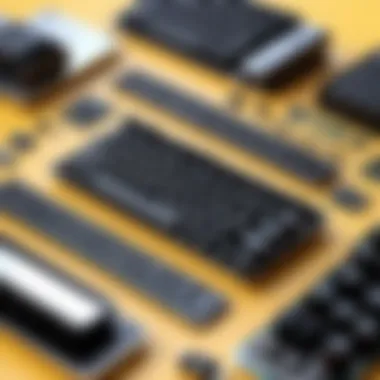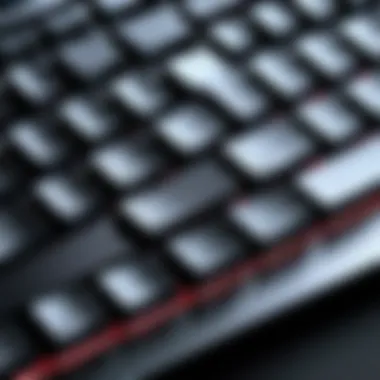How to Acquire Your Perfect Custom Keyboard: A Complete Guide


Intro
In the realm of technology, the desire for personalized experiences has heightened across various devices, and keyboards are no different. Custom keyboards offer not just utility, but individual expression. This comprehensive guide will delve into acquiring a custom keyboard, from understanding its components to distinguishing between pre-built and DIY options. If you wish to elevate your typing experience, knowledge of these aspects can significantly enhance your decision-making process.
Understanding Keyboards and Their Components
Before embarking on the journey of customizing your keyboard, it is fundamental to understand the critical components that contribute to its functionality and performance.
- Key Switches: The heart of any keyboard, key switches determine how your keyboard feels and responds. Variants include mechanical, membrane, and hybrid switches, each with different feedback and sound characteristics.
- Keycaps: Available in various shapes, sizes, and materials, keycaps play a significant role in aesthetics and tactile experience. Popular materials include ABS and PBT.
- PCB (Printed Circuit Board): This is the circuit that connects all the keys to your device. It influences the typing experience, both in terms of performance and compatibility.
- Casing: The external structure that holds the key components together. It is often made of plastic, aluminum, or acrylic, and greatly affects the overall look and feel of the keyboard.
- Stabilizers: Used for larger keys, these minimize wobble and improve typing consistency. They can be clip-in or screw-in styles.
By familiarizing yourself with these components, you establish a solid foundation that will aid in your customization process.
Assessing Your Needs and Preferences
Before you delve into choosing parts, assess your unique needs. Think about the following factors:
- Typing Style: Different switches cater to various typing habits. Are you a light typist or someone who tends to bottom out each keystroke?
- Aesthetic Preferences: Do you prefer a minimalist look or an extravagant, colorful setup? Choices in keycaps and cases can help you personalize your keyboard's appearance.
- Ergonomics: Consider if your typing habits require an ergonomic design. Some keyboards come with wrist rests and adjustable angles.
By creating a distinct picture of what you want, it helps streamline your search for the perfect custom keyboard.
Pre-Built vs.
DIY Keyboards
The path to acquiring a custom keyboard can take two routes: pre-built or DIY.
- Pre-Built Custom Keyboards: These are factory-assembled and often have customizable features like backlighting and macros. Brands like Keychron and Glorious PC Gaming Race allow users to choose layouts and sometimes even switch types without needing assembly skills or tools.
- DIY Custom Keyboards: Building your own keyboard allows full control and personalization. This process includes selecting each component and configuring it to your liking. Sites like Banggood and AliExpress can be beneficial for sourcing components.
The choice between pre-built and DIY largely hinges on your enthusiasm for assembly and detail. DIY can be rewarding but requires effort and patience.
Epilogue
Acquiring a custom keyboard involves a thorough understanding of both your needs and the key components that define the keyboard experience. Choosing between pre-built and DIY setups allows users the flexibility to balance convenience with customization that resonates with their keyboard philosophy. As our dependency on comfortable and tailored typing devices increases, really investing time in understanding available options becomes essential.
Ultimately, a custom keyboard can profoundly alter daily interaction with technology, infusing both utility and personalization into a device used almost every day.
Understanding Custom Keyboards
The world of custom keyboards is an intriguing mix of technology and user preference. Custom keyboards offer tangible benefits in ergonomics, aesthetics, and key performance. Understanding this category of keyboards facilitates informed decisions and enhances the typing experience. Tailoring a keyboard to individual needs is not just a luxury; it can lead to greater productivity and satisfaction. Whether for work, gaming, or general use, knowing the options and advantages of custom keyboards is pivotal.
Benefits of Choosing Custom Keyboards
Opting for a custom keyboard can significantly impact both comfort and functionality. One major benefit is ergonomics. A well-designed custom keyboard can reduce strain during long usage periods. Personalization is another essential feature. Users can select materials, colors, and layouts that match their preferences, which can enhance enjoyment and engagement while typing.
Additionally, many custom keyboards allow for top-notch mechanical switches, enabling swift and tactile feedback. This element improves typing speed and overall efficiency. Custom keyboards also retain value better than standard options. Furthermore, they often include advanced technology and features that may not be present in mass-produced models.
Types of Custom Keyboards
Understanding the different types of custom keyboards is crucial for making the right choice. Three main types dominate the market: Mechanical Keyboards, Membrane Keyboards, and Hybrid Keyboards.
Mechanical Keyboards
Mechanical keyboards are highly regarded for their performance. The distinctive characteristic of these keyboards revolves around the mechanical switches. Each key has its own switch, frying responsiveness that many users appreciate. This type of keyboard is popular among typists and gamers who require precision and speed.
The unique feature of mechanical keyboards is the wide variety of switch types available. Users can select from tactile, linear, or clicky switches to tailor their experience. The primary advantages are durability and customizable switches. However, mechanical keyboards can be louder than other types, which might not suit every environment.
Membrane Keyboards
Membrane keyboards contain a different mechanism. These utilize a pressure pad system beneath the keys, which leads to a quieter typing experience. The key characteristic of this type is its cost-effectiveness. Membrane keyboards tend to be more affordable, making them a popular option in both home and office settings.
While membrane keyboards cover the basics well, they do lack the semblance of tactile feedback present in mechanical keyboards. This may affect typing speed over extended sessions. Also, their build quality can be lower, leading to a reduced lifespan compared to mechanical models.
Hybrid Keyboards


Hybrid keyboards blend elements from both mechanical and membrane options. They often feature mechanical key switches, but incorporate aspects of membrane technology. The key characteristic of hybrid keyboards lies in their versatility and range of features.
This type tends to be a balanced choice, targeting users who desire the tactile feel of mechanical keys along with a quieter association. However, they can sometimes compromise on both feedback and sound, leading to mixed reviews among seasoned users.
Each type of keyboard has its strengths and weaknesses. Evaluation of personal requirements will greatly influence the best choice for custom keyboards.
Components of a Custom Keyboard
Understanding the components of a custom keyboard is crucial for making informed decisions during your customization process. Each part plays a significant role in enhancing user experience, functionality, and aesthetic appeal. A detailed exploration of these components reveals why careful selection can lead to a keyboard that meets individual needs effectively.
Key Switches: Types and Features
Key switches fundamentally determine how a keyboard feels and performs. They come in different categories, each contributing unique traits to the typing experience.
Mechanical Key Switch Categories
Mechanical key switches are often favored in the world of custom keyboards. They feature individual switches beneath each key, making them durable and responsive. There are various categories, commonly including Cherry MX, Gateron, and Kailh. Each brand often produces switches with distinct characteristics.
These switches can be categorized based on their operation and feel. For instance, some are linear with a smooth keypress, while others might have a tactile bump.
- Durability: They typically last longer than membrane switches, often rated for over 50 million keystrokes.
- Customization: Mechanical switches provide greater versatility regarding actuation force and sound options.
While they might come at a higher price, the experience and performance often justify the expense, attracting many enthusiasts.
Tactile vs Linear vs Clicky
When examining the types of mechanical switches, tactile, linear, and clicky switches stand out. The response feel varies between these types.
Tactile switches, such as Cherry MX Brown, provide a noticeable bump during keypresses without a loud sound, striking a balance between feedback and quiet operation. This make they beneficial for both typing and gaming.
Linear switches like Cherry MX Red offer a smooth keypress without feedback or sound, popular among gamers who need speed and silence.
On the contrary, clicky switches, like Cherry MX Blue, provide both tactile feedback and a distinctive sound, which might not please everyone but appeals to those seeking satisfying audible cues in their typing experience.
This characteristic means that switch selection directly influences comfort and productivity, highlighting the importance of hands-on testing.
Keycaps: Material and Design
The keycaps also shape how a keyboard feels and looks. Material choice and design ultimately impact durability, texture, and visual appeal.
ABS vs PBT Keycaps
When it comes to keycap materials, ABS and PBT reign supreme. ABS keycaps tend to be cheaper but can wear down more quickly. They may become shiny over time, losing their initial texture.
- Cost-Effective: Generally, ABS is more affordable and has vibrant color options.
- Legend Fading: Over time, letters can wear off the surface, requiring replacements.
PBT keycaps, conversely, are known for their durability and resistance to wear. Their structure ensures a direct impact on the long-term use of the keyboard.
- Stability: They do not become shiny and retain their texture longer.
- Color Stability: PBT is less likely to fade from UV exposure.
Given these factors, PBT keycaps might offer practical long-term gains versus ABS, which may seem appealing initially.
Profile Types and Aesthetics
Keycap profiles considerably influence both typing posture and overall aesthetic appeal. Common profile types include SA, DSA, and Cherry, among others. Each profile varies in shape and height, catering to diverse user preferences.
- Ergonomics: Higher profiles like SA can affect finger positioning.
- Design Cohesion: Aesthetic mods may also combine with different color themes.
It’s beneficial to understand the relationship between comfort and design. Misjudging these might lead users to uncomfortable situations while typing or gaming.
PCB Basics: The Heart of the Keyboard
The printed circuit board (PCB) is the central component in a keyboard. It translates key presses into signals that the computer can understand. The design types of PCBs, including hot-swap and non-hot-swap, play a decisive role in relaying what switches are appropriate for layouts.


PCBs also determine the necessary wiring and function capabilities of the custom keyboard. More advanced options support programmable keys, enhancing user control.
Case and Frame Considerations
The case and frame of a keyboard houses all operational components. The material and design choices impact durability, weight, and aesthetic appeal.
- Materials: Options range from plastic to aluminum and wood. Each yields distinct acoustic qualities.
- Design: Users should also consider plate typing options, which affect key travel.
These considerations ensure not only that a keyboard looks good but also that it can withstand everyday use effectively.
Buying a Pre-Built Custom Keyboard
Choosing to buy a pre-built custom keyboard offers a simpler and often more efficient path for keyboard enthusiasts. It is the perfect option for those who may lack the time, skills, or confidence to build their own keyboard from scratch. Pre-built custom keyboards come in a variety of designs and layouts, allowing users to select models that match their personal styles and functional needs.
Pre-built keyboards not only provide convenience but often also present high-quality components right out of the box. These models are generally optimized for comfort and performance, with many brands investing resources into their engineering and ergonomics.
However, it is critical to do some research on brands before making a purchase. This minimizes the risk of issues down the line, such as mechanical failures or compatibility problems with different operating systems. Always check reviews and community feedback regarding any model being considered.
Popular Brands and Models
The market boasts certain reputable brands recognized for their reliability and customizability. Brands like Keychron, Ducky, and Anne Pro each offer various models catering to distinct preferences in aesthetic, switch type, and usage scenarios. Investing in a product from one of these brands not only means reliability but also attention to detail in design and performance.
Where to Purchase Custom Keyboards
Online Retailers
Online retail options for purchasing custom keyboards are vast. Websites like Amazon and Newegg tend to have lots of stock and options available. A key characteristic of online retailers is the speed and convenience they offer. Shopping online allows you to compare prices, check for discount offers, and also read extensive customer reviews, making it easier to make informed decisions.
One unique feature of online retailers is the ability to check for availability and shipping options in real-time. This is an advantage because you can select models that are currently in-stock and choose the best shipping option according to your urgency.
However, one downside can be the lack of tactile customization before purchase. This means one can't feel the keyboard’s performance, key switches, or the build quality physically before pressing the order button.
Specialty Stores
Specialty stores often provide a curated assortment of custom keyboards, typically showcasing lesser-known brands and unique designs. This can be particularly appealing for users searching for a keyboard that aligns more closely with their personal tastes. A sharp characteristic of specialty stores is the chance to physically experience keyboards and interact with staff that typically know the products well.
A key advantage here is the opportunity for hands-on testing. You can ascertain switch types and keycap materials first-hand, which aids understanding of how different configurations impact keyboard feel.
This direct interaction can also pose a challenge; due to space limitations, not all stores stock a diverse array of models. Finding your desired keyboard might be less straightforward compared to online searches.
Pricing: What to Expect
In understanding pricing for pre-built custom keyboards, one must anticipate a range from budget-friendly to high-end models. A starter keyboard might cost under one hundred dollars, whereas premium keyboards can surpass five hundred.
When exploring pricing, keep in mind the factors that influence cost, such as brand reputation, switch type, material quality, and additional features like RGB lighting. It's smart to align your budget with what you truly need, ensuring that any keyboard you choose satisfies both functionality and price expectations.
Building Your Own Custom Keyboard
Building your own custom keyboard is a rewarding experience. It allows complete control over the construction, design, and overall performance. This section focuses on practical steps involved in creating a custom keyboard.
Necessary Tools and Equipment
Before embarking on the building process, gathering the right tools and equipment is vital. An organized workspace will help streamline the building process. Key tools include:
- Soldering iron: Essential for permanent connections if your PCB is not hot-swappable.
- Wire cutters: Useful for trimming excess wire.
- Phillips screwdriver: Required for assembling the case and securing other components.
- Keycap puller: Helps remove existing keycaps with minimal damage.
- Tweezers: Assist in handling small components.
- Multimeter: To check for electrical connections.
These tools, while common, are essential for attaining precision and ensuring durability in your custom keyboard.
Step-by-Step Building Process
Preparing the PCB
First, start with preparing the PCB. This means ensuring it is clean and without dirt. Proper preparation contributes to better connectivity and reduces the risk of faults. Understanding the layout is another key characteristic. Each PCB can have various layouts that support different switch mounts. A well-prepared PCB enhances the efficiency of soldering and component installation. One must also pay attention to the orientation of components, which is crucial for proper function.


Installing Switches
Next, proceed to installing switches. Each switch makes up the core of the keyboard, responding to your input. When approaching installation, consider the types of switches. Their characteristics range from feel to sound. Slide them into the designated slots ensuring a snug fit. This step greatly influences the typing experience. A well-installed switch provides tactile feedback and longevity. Focus on the alignment for reaching optimal performance.
Securing the Keycaps
After that, securing the keycaps is the final touch of the building process. Place each keycap onto its switch, ensuring it clicks into place. This gives the keyboard its functional detail and aesthetic feel. Properly secured keycaps also help in durability and convenience. A notable point is the variety of keycap styles and materials; this allows personal expression during customization. Having a stable fit prevents future issues like wobbling or disfigurement.
Soldering vs Hot-Swap
This section is debated among keyboard enthusiasts. Soldering is traditional and can provide a robust final product. However, it can be permanent. If a switch breaks, heating up solder requires diligence. On the other hand, hot-swap technology is becoming common in modern keyboards. This allows users to replace switches without soldering. This raises a question of which is better: dependability or flexibility? Each method has pros and cons. Those wanting a spectacular build may appreciate soldering, while those favoring adaptability may lean toward hot-swappable designs.
Customization Beyond the Basics
When it comes to custom keyboards, going the extra mile in personalization can greatly enhance one’s experience. Basic customizations such as switch types and keycap designs are just the beginning. By venturing beyond these, users can tailor aesthetics, functionality and improve usability according to their preferences.
Software for Keyboard Customization
Software plays a vital role in the effective customization of keyboards. Advanced keyboard software, like QMK and VIA, offers numerous functionalities. Users can reassign key functions, create macros, and adjust RGB lighting.
- Reassignment of Keys: This allows users to assign different functions to keys. Changing the layout can speed up typing or improve accessibility.
- Macros: Macros are sequences of commands initiated with a single keypress. In programming or gaming, a well-crafted macro can save significant time.
- Lighting Control: Many users appreciate aesthetics. So, having software that controls lighting effects is desirable. Users can choose static effects, reactive effects based on key presses, or animations that bring a theme to life.
Choosing intuitive software aligns with user experience needs. It’s advisable to select keyboards compatible with well-supported software platforms for a smoother customization process.
Unique Design and Aesthetic Options
In the realm of custom keyboards, aesthetics is as important as function. Manufacturers and modders alike experiment with various designs and themes.
- Keycap Styles: There is an ocean of keycap styles. Options vary from colorful novelty sets to minimalist designs. Different profiles such as SA, DSA, or CHERRY influence key height and typing behavior, making them crucial to a tailored experience.
- Case Variations: The keyboard case can impact overall look. Options range from sleek metal cases to vivid polycarbonate designs, reflecting personal flair. Even case color and finish are wise considerations while customizing.
- Artisan Keycaps: For those who wish to make a standout statement, artisan keycaps made by various artists add elegance. They can reflect personal interests - gaming themes, pop art, etc.
Customization isn't merely about how a keyboard looks but how its elements reflect user identity and preferences. Finish and colors should also resonate with surroundings for cohesive desk aesthetics. By exploring all the options available for software and design, users ensure their keyboard aligns perfectly with their needs and preferences, effectively transcending basic customization.
Maintaining Your Custom Keyboard
Keeping a custom keyboard in optimal condition is vital. Regular maintenance ensures longevity and functionality. Proper care avoids wear and tear, prolonging the control and feel you expect from a personalized device.
Cleaning Techniques and Tips
Maintenance begins with cleaning. Dust and debris accumulate, which can lead to malfunction or discomfort during typing. Here are essential steps to effective cleaning:
- Remove Keycaps: Start by gently pulling off the keycaps using a puller. This allows access to the underlying surface.
- Use Soft Tools: Employ a soft brush or compressed air to clear away dust from the switches and PCB. Avoid harsh chemicals.
- Wipe Surfaces: Use a damp microfiber cloth for surfaces, including the case and frame. Ensure the cloth is not overly wet to prevent damage.
- Deep Clean Occasionally: For a thorough clean, soak keycaps in warm soapy water and scrub with a soft brush, rinsing and drying them completely before reassembly.
Proper cleaning frequency varies but aim to do it every one to three months, depending on usage.
When to Replace Components
Maintaining your custom keyboard includes knowing when something needs replacement. Ignoring wear can lead to long-term issues. Consider the following:
- Key Switch Wear: Over time, key switches may lose responsiveness or produce inconsistent feedback. If pressing feels off, consider replacing them.
- Faded Keycaps: Aesthetics matter. If you notice discoloration or loss of texture on your keycaps, it's time for replacements for a fresher look.
- Failed PCB: If certain keys become unresponsive, check connections. A failing PCB might require replacement. Sometimes, soldered parts need attention.
- Cables and Connectors: Signs of fraying or instability in cable can suggest its time for a new one to maintain connection quality.
Keeping an eye on these elements of maintenance helps preserve your typing experience. Avoid issues by implementing chast activity, and be proactive on repairs or replacements, to extend the life of your custom keyboard.
Epilogue: Making the Right Choice
Choosing a custom keyboard involves thoughtful consideration of several elements. These keyboards are not only tools for typing; they can enhance your ergonomic comfort and personal style. Regardless of whether you prefer a pre-built model or wish to embark on a DIY journey, understanding the factors involved will lead to a more fruitful outcome.
Several benefits accompany the decision to opt for a custom keyboard. Personalization is a significant aspect. Users can troubleshoot issues specific to their own use cases, be it adjusting the feel of key switches, altering the design of keycaps, or even selecting specific layouts for productivity. Consequently, these elements collectively enhance typing efficiency and comfort.
Moreover, considering your own typing habits will direct you towards the keyboard features most beneficial to you. Always evaluate whether you require a more tactile response in key switches or seek quieter performance.
Another important consideration is compatibility. The choice of a product must align with not just personal preference but also existing hardware and software. Ensure that any custom keyboard will work seamlessly with your operating systems and applications. Often overlooked, these nuances can affect usability.
Final Thoughts on Custom Keyboards
In summary, selecting the right custom keyboard is an immersive experience designed to create an optimal typing environment. As you explore possible configurations, the learning curve may seem daunting, yet the investment of time can yield substantial returns.
- First, reflecting on intended use clarifies the features needed. Serious gamers might prioritize fast response times, while remote workers may require comfort-focused setups.
- Transparency is key. Engaging with community resources, such as forums on Reddit, can provide insights from other users who share their experiences about various models.
Ultimately, whether assembling or purchasing, an informed decision will cultivate a unique typing experience tailored to your needs. As custom keyboard culture continues to develop, keep abreast of evolving trends and emerging tools. Explore new layouts, switch options, and productivity-enhancing modifications to elevate your proficiency.
Remember, your keyboard is an extension of you - choose wisely.







